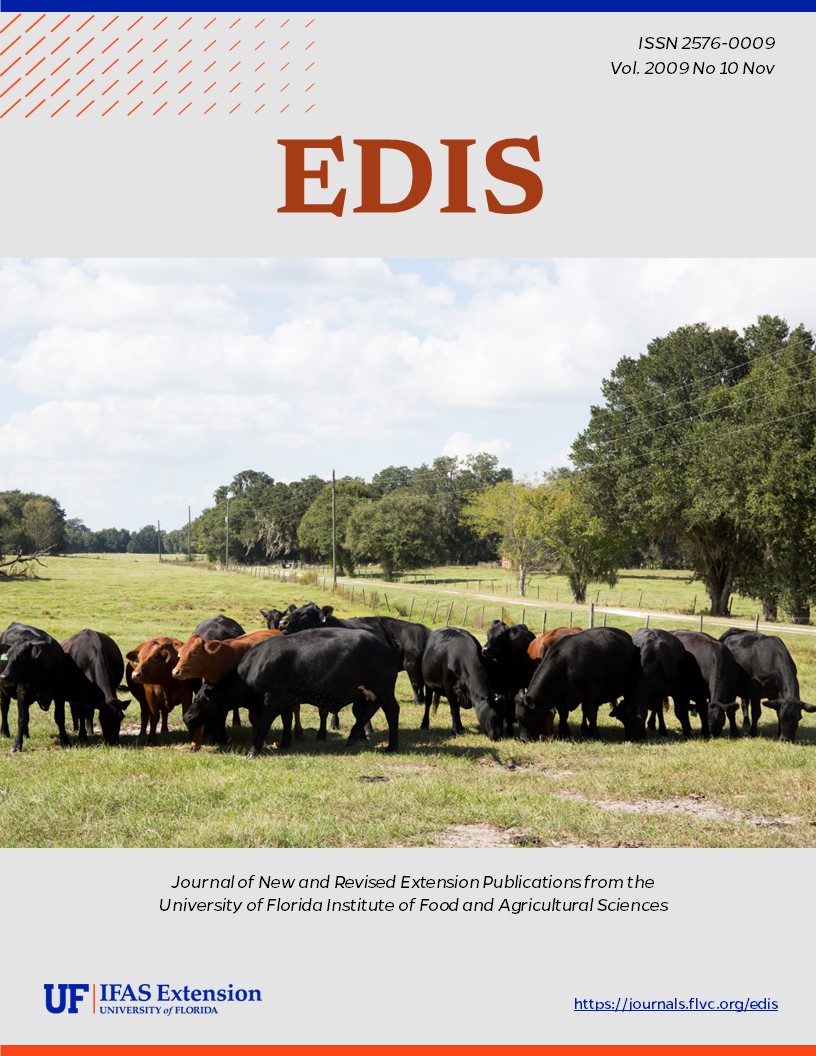Abstract
EENY457, a 6-page illustrated fact sheet by Stephanie Larrick and Roxanne Connelly, is part of the Featured Creatures collection. It describes this medium-sized brown mosquito that exists throughout the tropics and the lower latitudes of temperate regions and is a vector of many pathogens, several of which affect humans — synonymy, distribution, description, life cycle, medical importance, and management. Includes references. Published by the UF Department of Entomology and Nematology, November 2009.
EENY457/IN837: Southern House Mosquito Culex quinquefasciatus Say (ufl.edu)
References
AMCA. (2005). Mosquito Information: Control. American Mosquito Control Association. http://www.mosquito.org/mosquito-information/control.aspx (2 June 2009).
Barr AR. 1957. The distribution of Culex p. pipiens and C. p. quinquefasciatus in North America. Journal of Tropical Medicine and Hygiene 6: 153-165. https://doi.org/10.4269/ajtmh.1957.6.153
Bates M. 1949. The Natural History of Mosquitoes. Macmillian Company. New York, NY. 379 pp.
Belkin JN. 1977. Quinquefasciatus or Fatigans for the tropical (southern) house mosquito (Diptera: Culicidae). Proceedings of the Entomological Society of Washington 79: 45-52.
CDC. (June 2007). CDC answers your questions about St. Louis encephalitis. Center for Disease Control. http://www.cdc.gov/sle/technical/fact.html (2 June 2009).
CDC. (October 2007). Saint Louis Encephalitis. Center for Disease Control. http://www.cdc.gov/sle/(2 June 2009).
Connelly CR. 2006. Common Mosquitoes of Florida UF/IFAS. Card Set. SP 370
Cutwa-Francis MM, O'Meara GF. (2008). Culex quinquefasciatus. Identification Guide to Common Mosquitoes of Florida. http://fmel.ifas.ufl.edu/key/genus/culex_quin.shtml (4 June 2009).
Darsie Jr RF, Morris CD. 2000. Keys to the adult females and fourth-instar larvae of the mosquitoes of Florida (Diptera: Culicidae). Technical Bulletin of the Florida Mosquito Control Association 1: 148-155.
Darsie Jr RF, Ward RA. 2005. Identification and Geographical Distribution of the Mosquitoes of North America, North of Mexico. University of Florida Press. Gainesville, FL. 300 pp.
Day JF, Stark LM. 2000. Frequency of Saint Louis encephalitis virus in humans from Florida, USA: 1990-1999. Journal of Medical Entomology 37: 626-633. https://doi.org/10.1603/0022-2585-37.4.626
DHPE. (2005). Rift Valley Fever. Directors of Health Promotion and Education. http://www.dhpe.org/infect/rift.html (2 June 2009).
Fonseca DM, Keyghobadi N, Malcolm CA, Mehmet C, Schaffner F, Mogi M, Fleischer RC, Wilkerson RC. 2004. Emerging Vectors in the Culex pipiens Complex. Science 303: 1535-1538. https://doi.org/10.1126/science.1094247
Foster WA, Walker ED. 2002. Mosquitoes (Culicidae), pp. 245-249. In Mullen G, Durden L. (editors). Medical and Veterinary Entomology. Academic Press. New York, NY. https://doi.org/10.1016/B978-012510451-7/50014-1
Gerberg EJ, Barnard DR, Ward RA. 1994. Manual for Mosquito Rearing and Experimental Techniques. American Mosquito Control Association Bulletin No. 5: 61-62.
ITIS. 2009. Culex quinquefasciatus Say, 1823. Integrated Taxonomic Information System. http://www.itis.gov/servlet/SingleRpt/SingleRpt?search_topic=TSN&search_value=126490 (2 June 2009).
Kern WH. (September 2007). Some small native freshwater fish recommended for mosquito and midge control in ornamental ponds. EDIS. http://edis.ifas.ufl.edu/IN456 (2 June 2009).
King WV, Bradley GH, Smith CN, McDuffie WC. 1960. A Handbook of the Mosquitoes of the Southern United States. Agriculture Handbook No. 173. United States Department of Agriculture. Washington D.C. pp. 118-119.
Lima CA, Almeida WR, Hurd H, Albuquerque CM. 2003. Reproductive aspects of the mosquito Culex quinquefasciatus (Diptera: Culicidae) infected with Wuchereria bancrofti (Spirurida: Onchocercidae). Memórias do Instituto Oswaldo Cruz. 98: 217-222. https://doi.org/10.1590/S0074-02762003000200009
Mavalankar D, Shastri P, Bandyopadhyay T, Parmar J, Ramani KV. (February 2008). Increased mortality rate associated with chikungunya epidemic, Ahmedabad, India. Emerging Infectious Diseases. http://www.cdc.gov/EID/content/14/3/412.htm (2 June 2009). https://doi.org/10.3201/eid1403.070720
Mosquito Information website. (2009). University of Florida, Florida Medical Entomology Laboratory. http://mosquito.ifas.ufl.edu/Index.htm (2 June 2009).
O'Meara GF. (2003). Mosquito associated with stormwater detention/retention areas. EDIS. http://edis.ifas.ufl.edu/mg338 (2 June 2009).
Savage HM, Anderson M, Gordon E, McMillen L, Colton L, Charnetzky D, Delorey M, Aspen S, Burkhalter K, Biggerstaff BJ, Godsey M. 2006. Oviposition activity patterns and West Nile virus infection rates for members of the Culex pipiens complex, at different habitat types within the hybrid zone, Shelby County, TN, 2002 (Diptera: Culicidae). Journal of Medical Entomology 43: 1227-1238. https://doi.org/10.1603/0022-2585(2006)43[1227:OAPAWN]2.0.CO;2
Sirivanakarn S, White GB. 1978. Neotype designation of Culex quinquefasciatus Say (Diptera: Culicidae). Proceedings of the Entomological Society of Washington 80: 360-372.
Shroyer DA. (June 2004). Saint Louis encephalitis: a Florida problem. EDIS. http://edis.ifas.ufl.edu/MG337 (2 June 2009).
WRBU. (undated). Adult Culex quinquefasciatus. The Walter Reed Biosystematics Unit. http://wrbu.si.edu/SpeciesPages_non-ANO/Non-ANO_A-hab/CXqui_hab.html (2 June 2009).
WHO. (September 2000). Lymphatic filariasis. World Health Organization. http://www.who.int/lymphatic_filariasis/en/(3 June 2009).

